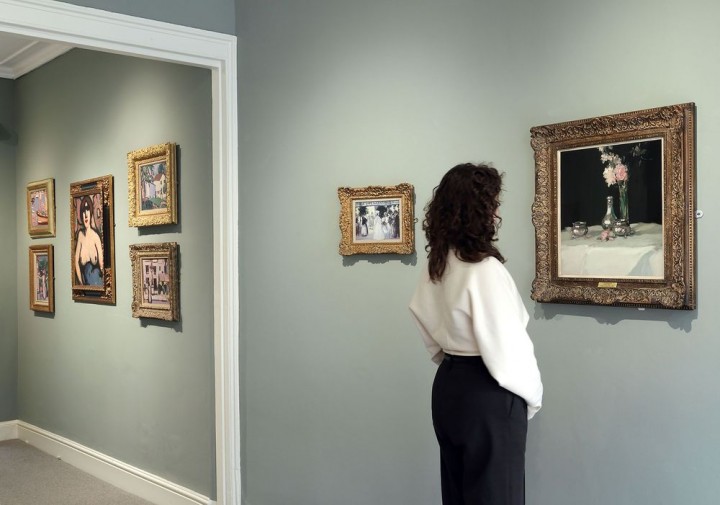Scottish Art News
Latest news
Magazine
News & Press
Publications
The Fleming Wyfold Art Foundation and Lyon & Turnbull mark J D Fergusson’s 150th anniversary with new exhibition
By Susan Mansfield, 15.03.2024

An exhibition to celebrate the 150th anniversary of the birth of the Scottish Colourist John Duncan Fergusson affirms the artist’s important role in the development of modernism in the UK.
In A Scottish Colourist at 150: J D Fergusson, fine art auctioneers Lyon & Turnbull, in partnership with the Fleming Wyfold Art Foundation, have brought together more than 25 paintings and sculptures from across Fergusson’s long career, all from private collections.
The important 1908 portrait ‘Rose in Her Hair’ will be offered for sale in Lyon & Turnbull’s Scottish Paintings and Sculpture sale on June 6. Fergusson and his wife, the dancer and choreographer Margaret Morris, will also be celebrated in a new display in Perth Art Gallery when it reopens on 30 March in Perth City Hall.
Alice Strang, senior specialist in modern and contemporary art at Lyon & Turnbull, who co-curated the show, says: “Fergusson was the longest lived of the four Scottish Colourists, with a 50-year career, and was also the most internationally significant. He plays a role in the birth of modern art as we know it which is unparalleled by any other British artist.”
Fergusson was born in 1874 in Leith, and was largely self-taught. Strang says: “He is emerging as an artist of confidence and talent in early 1900s with works like Portrait of Jean Maconochie (1902) and Jonquils and Silver (1905). He could easily and successfully have carried on doing these things, but he was more courageous and interested and imaginative.”
An inheritance from his father enabled him to move to Paris in 1907 where he mingled with the founding figures of modernism. Strang says: “He is seeing the very latest innovations of artists like Picasso and Matisse and makes something original of his own out of that.
While ‘Rose in Her Hair’, believed to be a portrait of his then partner, the anglo-American artist Anne Estelle Rice, shows a looser technique and a broader palette, ‘Painting Study no. 6’ (1910) shows him pushing into a truly modernist style. Strang says: “It’s the most incredible depiction of the power of womanhood. There is an extraordinary use of black, thick unhesitating brush strokes. It’s quite astonishing that it was painted by a Scot in Paris in 1910.”
Fergusson had met Margaret Morris in Paris in 1913 and, when the First World War broke out, the couple returned to London. Through Morris’s creative circle, Fergusson met the London avant-garde, include Wyndham Lewis and the Vorticists.
 J D Fergusson, Bathers, Antibes, 1937
J D Fergusson, Bathers, Antibes, 1937
In the 1920s and 1930s, the couple spent time in the Cap D’Antibes, which was then being established as a luxury resort. Paintings such as ‘Bathers, Antibes’, and ‘Blonde in the Sun’ (both 1937) capture the art deco glamour of the era, as well as a theme to which Fergusson loved to return: the strong female form.
However, he also fell in love again with the country of his birth, taking driving tours of Scotland in 1922 and 1928. Two of the most significant paintings inspired by those trips, ‘A Puff of Smoke near Milngavie ‘(1922) and ‘The Drift Posts’ (1928), reveal how he brought the light and colours of France and the influence of painters like Cezanne to the Scottish landscape.
When the Second World War broke out, Fergusson and Morris settled in Glasgow where, once again, they became the centre of an artistic circle, providing support and encouragement to other creatives. Strang says: “We’re delighted to be showing the work in Glasgow because he played a key role in the re-energising of the Glasgow art world and he and Margaret are still remembered by a lot of people.”
The show also includes a group of sculptures by Fergusson, including an edition of his most famous, ‘Eastre (Hymn to the Sun)’, believed to be a portrait of Morris, and several others inspired by modernist forms and by the non-Western sculptures he saw in Paris’s Trocadéro Museum. Strang says: “Not many people know he was a serious sculptor and exhibited his sculpture for 30 years. There is a wonderful story to be told about his work.”
A Scottish Colourist at 150: J D Fergusson will be at Lyon & Turnbull, Glasgow until 22nd March




